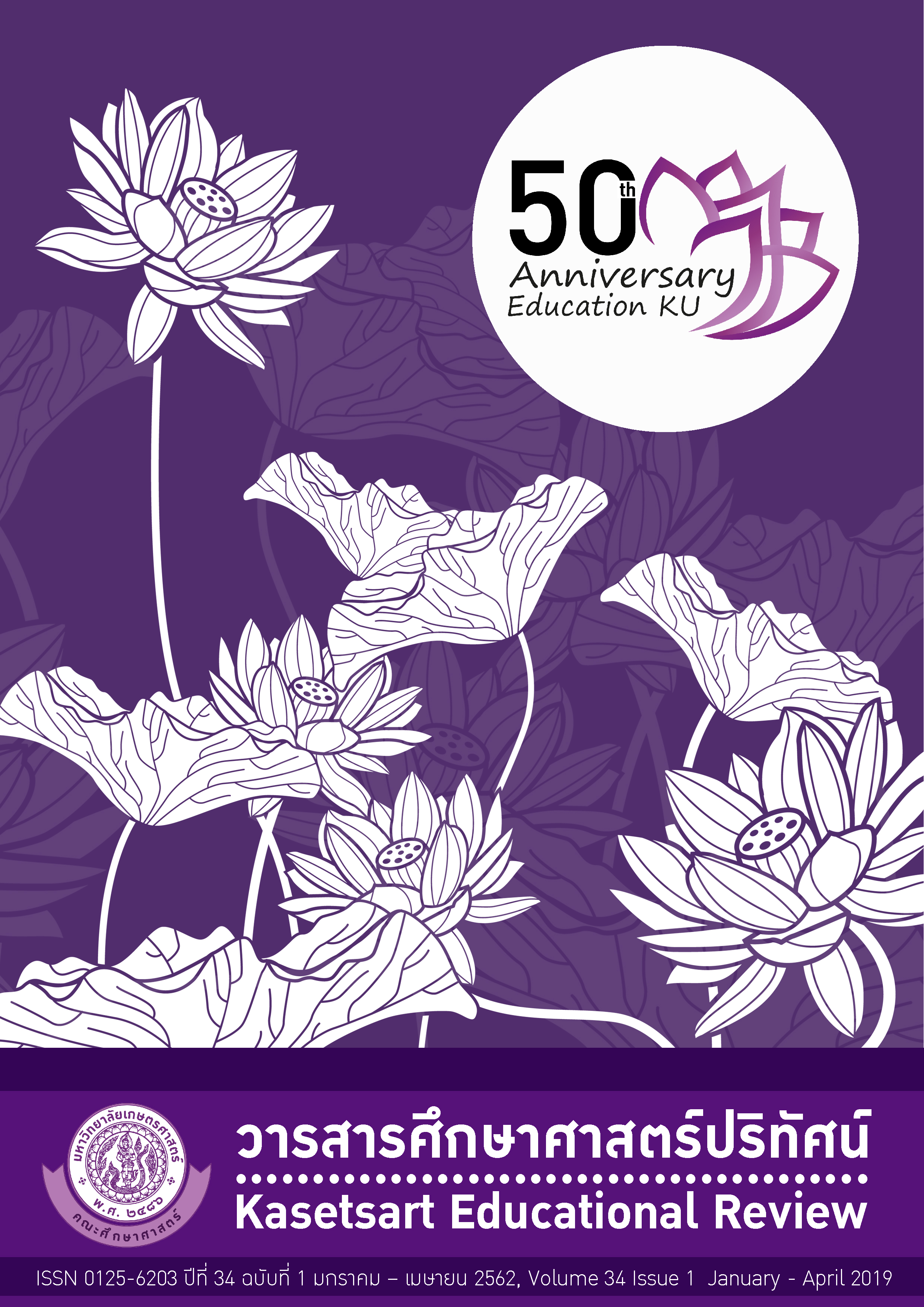การศึกษาความคิดสร้างสรรค์ทางวิทยาศาสตร์ของนักเรียนระดับชั้นมัธยมศึกษาปีที่ 4 ตามกรอบแนวคิด The Scientific Structure Creativity Model (SSCM)
คำสำคัญ:
ความคิดสร้างสรรค์, ความคิดสร้างสรรค์ทางวิทยาศาสตร์, The Scientific Structure Creativity Modelบทคัดย่อ
การวิจัยครั้งนี้มีจุดประสงค์เพื่อศึกษาความคิด สร้างสรรค์ทางวิทยาศาสตร์ของนักเรียนชั้นมัธยมศึกษาปีที่ 4 จํานวน 27 คน ห้องเรียนพิเศษวิทยาศาสตร์ในวิชาชีววิทยา โดยใช้กรอบแนวคิดความคิดสร้างสรรค์ทางวิทยาศาสตร์จาก The Scientific Structure Creativity Model (SSCM) เครื่องมือที่ใช้คือ แบบทดสอบความคิด สร้างสรรค์ทางวิทยาศาสตร์ที่มีลักษณะเป็นคําถาม ปลายเปิดจํานวน 7 ข้อ ซึ่งเป็นการวัดความคิดสร้างสรรค์ ทางวิทยาศาสตร์ใน 3 มิติคือ มิติที่ 1 ด้านผลลัพธ์เป็นการวัดเกี่ยวกับความรู้หลักการและทักษะทางวิทยาศาสตร์มิติที่ 2 ด้านคุณลักษณะ และมิติที่ 3 ด้านกระบวนการ และวิเคราะห์ผลโดยให้คะแนนตามเกณฑ์การให้คะแนน จากนั้นหาค่าเฉลี่ยของนักเรียนในแต่ละข้อคําถาม แล้วนําเสนอข้อมูลในรูปตารางแสดงผล
ผลการวิจัย พบว่า การวัดความคิดสร้างสรรค์โดยใช้กรอบแนวคิดของ Hu และ Adey สามารถแยกความคิดสร้างสรรค์ทางวิทยาศาสตร์ทั้ง 3 ประเภท ได้แก่ ความคิดคล่อง ความคิดยืดหยุ่น และความคิดริเริ่มได้อย่างชัดเจน โดยนักเรียนมีระดับพัฒนาการของความคิดสร้างสรรค์ในองค์ประกอบด้านความคิดคล่องมากที่สุด โดยมีคะแนนเฉลี่ย คือ 4.40 รองลงมา คือ ความคิดยืดหยุ่น และความคิดริเริ่ม ซึ่งมีคะแนนเฉลี่ยคือ 3.00 และ 2.23 ตามลําดับ นอกจากนี้ยังพบว่า นักเรียนมีความคิด สร้างสรรค์ทางวิทยาศาสตร์ในมิติขององค์ประกอบมิติด้านผลลัพธ์ที่สัมพันธ์กับความเชี่ยวชาญเฉพาะเรื่องจินตนาการและกระบวนการคิดอยู่สูงกว่าความสัมพันธ์ในรูปแบบอื่น ๆ
เอกสารอ้างอิง
Al-Abdali, N. S. & Al-Balushi, S. M. (2016). Teaching for creativity by science teachers in grades 5-10. International Journal of Science and Mathematics Education, 14, 251-268. doi: 10.1007/s10763-01409612-3.
Amabile, T. M. (2012). Componential theory of creativity. Encyclopedia of Theory.
Cropley, A. J. (2000). Defining and measuring creativity: Are creativity tests worth using?. Roeper Review, 23(2), 72-79. doi: 10.1080/02783190009554069.
Hathcock, S. J., Dickerson, J. D., Eckhoff, A. & Katsioloudis, P. (2015). Scaffolding for creativity product possibilities in a design-based STEM activity. Research in Science Education, 45, 727-748. doi: 10.1007/s11165-014-9437-7.
Hengsagulwong, C. (2015). Fostering grade 10 Students’ scientific creativity through Integrated game with context-based learning in the topic of force and motion. (Master of Education, Kasetsart University). [in Thai]
Hu, W. & Adey, P. (2002). A scientific creativity test for secondary school students. International Journal of Science Education, 24(4), 389-403. doi:10.1080/ 09500690110098912.
Hung, W. (2015). Cultivating creative problem solvers: The PBL style. Asia Pacific Education Review, 16, 237-246. doi: 10.1007/s12564-015-9368-7.
Junthon, B. (2015). The Development of Grade 11 Students’ Scientific Creativity in the Learning Unit of Equilibrium Using 5E’s Scientific Inquiry Learning Approach. (Master of Education, Kasetsart University). [in Thai]
Khumkhuan, T., Jantarakantee, E. & Wanttana-amorn, P. (2015). Grade-10 students’ scientific creativity and gender. In Bangkok, 53rd Kasetsart University Annual Conference. (31-38). Bangkok: The Thailand Research Fund. [in Thai]
Lou, S. J., Lui, Y. H. & Shin, R. C. (2011). The senior high school students’ learning behavioral model of STEM in PBL. International Journal of Science and Mathematics Education, 21(2), 161-183. doi: 10.1007/s10798-010-9112-x.
Root-Bernstein, R. (2015). Arts and crafts as adjuncts to STEM education to foster creativity in gifted and talented students. Asia Pacific Education Review, 16, 203-212. doi: 10.1007/s12564-015-9362-0.
Wurdinger, S. & Qureshi, M. (2015). Enhancing College Students’ Life through Project Based Learning. Innovation High Education, 40(3), 279-286. doi: 10.1007/s10755-014-9314-3.
Zhou, C. (2012). Integrating creativity training into Problem and Project-Based Learning curriculum in engineering education. European Journal of Engineering Education, 37(5), 488-499. doi: 10.1080/03043797. 2012.714357.
ดาวน์โหลด
เผยแพร่แล้ว
ฉบับ
ประเภทบทความ
สัญญาอนุญาต
บทความทุกบทความเป็นลิขสิทธิ์ของวารสารคณะศึกษาศาสตร์ มหาวิทยาลัยเกษตรศาสตร์ วิทยาเขตบางเขน
วารสารศึกษาศาสตร์ปริทัศน์ (Kasetsart Educational Review)






